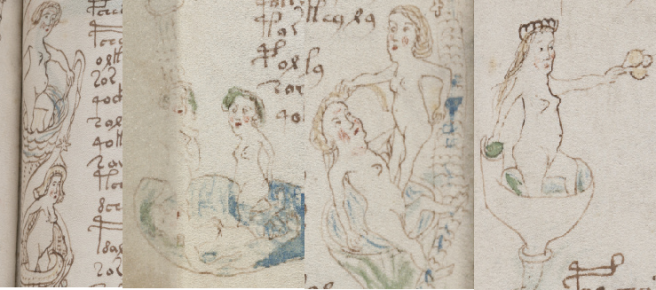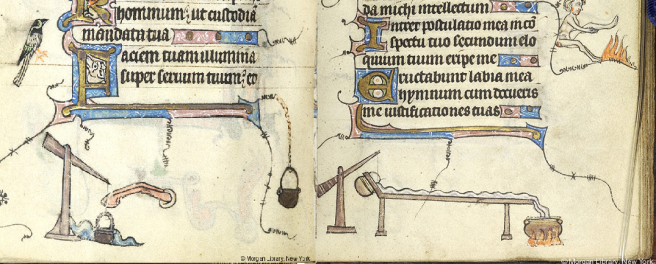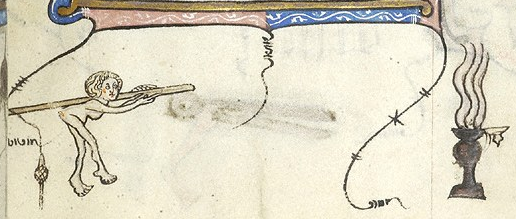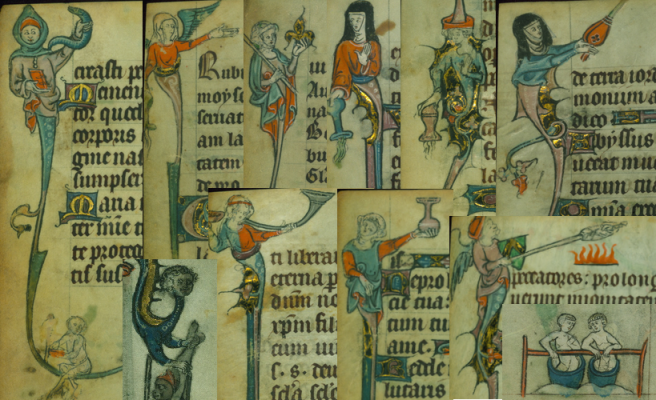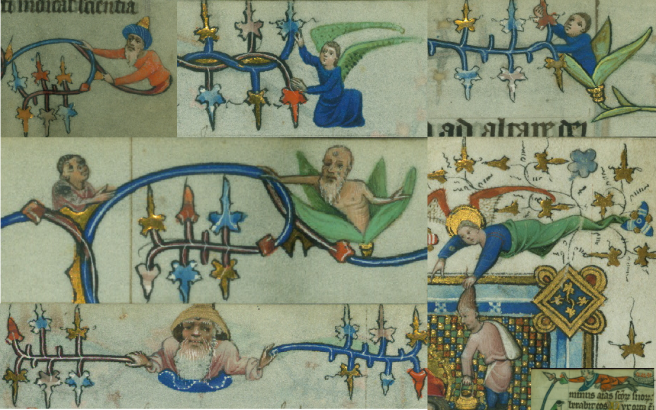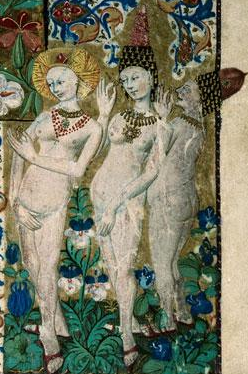One of the arguments against the idea that the Q13M illustrations in the lateral margins belong to the drollery family of illustrations (which I explored in my last post) is the fact that the Voynich figures are labeled.
In this post I would like to present a few refinements to this notion, and also look at what kind of information we can glean from labeled drolleries.
First of all, let’s look at the actual frequency of labels in Q13M.
Pages with systematic labels: 77r.
Pages where only some of the figures have labels: 77v, 80r, 82r&v, 83r&v.
Pages without labels: 76v, 79r&v, 80v.
Total systematically labeled pages in Q13M: 1
Total partially labeled pages in Q13M: 6
Total unlabeled pages in Q13M: 3
It should be noted that the folios of Q13M are much more likely to have either no labels (3 out of 10) or only partial ones (6 out of 10). Why are some figures labeled and not others? The coexistence of labeled and unlabeled figures on the same folios deserves more attention.
Counting labeled vs unlabeled figures for Q13M, out of a total of 87 human figures, only 34 are labeled. The majority of the Q13M figures are therefore not labeled.
Of those 34, only 5 occur in the lateral margins. All the others are either in the haut-de-page or bas-de-page illustrations.
Such proportions cannot be insignificant: the fact that the upper and lower marginal illustrations almost always contain labels, but the lateral ones almost never do, cannot be ignored when we analyze the Q13M illustrations.
What we can see is that in the overwhelming majority of cases, the marginal nymphs are not labeled. The labels in Q13M are almost always present near nymphs who are in the haut-de-page or bas-de-page illustrations. Voynich f80r is a particularly good example of this: there is a profusion of labels in the upper margin scene, but none near any of the side margin figures.
With these numbers in mind, let’s get back to the subject of drolleries. First of all, while it is true that most of the time drolleries were not labeled, this is not always the case, as in the example below.
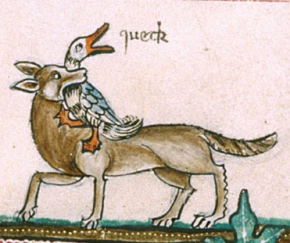
The layout of labeled vs unlabeled illustrations in Q13M actually matches up quite well with what can be observed in other illuminated manuscripts, such as BNF NAL 3255. The bas-de-page scenes are not drolleries: they illustrate subjects that are related to the overall main theme of Christianity, but are not an illustration of the text on the page; while the Breviary contains prayers, the illustrations refer to core concepts and rituals of Christianity, saints, virtues, etc. They have labels which make the reference explicit for the reader. The unlabeled illustrations in the lateral margins are drolleries: they are unlabeled because they have no purpose other than to decorate the page and amuse the reader.
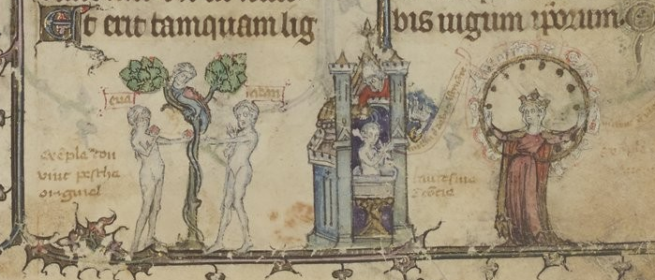
BNF NAL 3134, a book of hours, shows another type of labeled drolleries: here again the lateral margins are unlabeled and pure fantasy, but the bas-de-page ones comically illustrate popular expressions and local proverbs, which are written out in the adjoining labels.
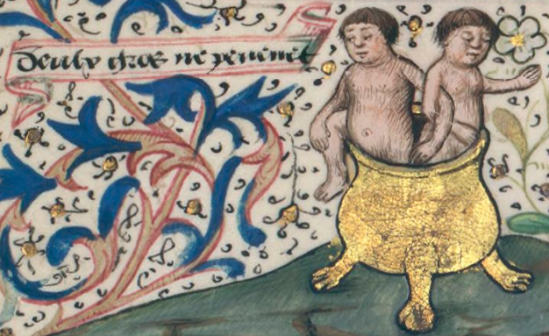
Another type of labeled drollerie is found in BNF Latin 10435, a psalter from Picardy. Here again, the true drolleries are unlabeled, while the bas-de-page illustrations are labeled in red. The scenes depicted in the bottom margins are meant to be charming or slightly silly, and unrelated to the text. The characters in them are labeled with names and titles: they are contemporary people from Picardy, presumably friends and acquaintances of the patron. It is interesting to note that in this case, the labeling is the only thing that sets apart these “portraits” from the drolleries: the characters are indistinguishable, pictured in similar dress and poses, aside from the fact that the portraits are labeled. It is almost as if the labels had been added afterwards, with the identifications serving to further amuse the patron. In this example the labels do not denote an illustration that is intrinsically more significant than the others, but rather, the addition of the label itself is what confers special, personal meaning to an otherwise mundane drollery.
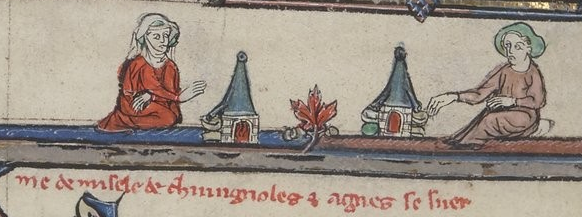
My tentative conclusion to this exploration is that the scenes which take place in the upper and lower margins of Q13 may be actual illustrations of significant material, which may be direct illustrations of the main text, or may tell a completely different story like the proverbs of BNF NAL 3134. The figures in the side margins, however, may very well be pure drollery. They keep with the nude bathing theme of Q13, in the same way that the characters dressed as nuns in the drolleries of books of Hours echo its religious content, but like the playful nuns, they are not an illustration of the text. The labels are the only thing that differentiate them from the nymphs in the upper and lower margins, just like the characters which populate the margins of BNF Lat 10435.
Further support for the idea that the lateral marginal nymphs of Q13M are drolleries is the fact that the side-margin figures tend to recur: the ring bearer, the Thing holder, etc, are repeated and also their poses are repeated even when the objects they hold vary. Jean Wirth, in his massive tome¹ about drolleries, laid down the rules of drollery identification. Among them, the following one is particularly useful here: “We shall therefore establish a second rule for interpretation: The possibility of an allusion is inversely proportional to the frequency of the iconographic motif” (p.21): in other words, the more often a marginal figure’s form is repeated within a manuscript, the higher the probability that it does not in fact allude to anything significant. This runs counter to the way the Q13M nymphs have been analyzed so far, including in my own initial post on this blog: the impulse is to think that if a form is occurs repeatedly, it must be significant. In the world of drolleries, the opposite is true.
We can easily see this in the repetition of nearly identical figures in the side margins of the manuscripts shown in my previous post, which are meaningless, while the one-off depiction of a scene (usually in the bas-de-page) is generally significant, either connected to the main text or to another narrative or reference.
How does this help us with the Voynich manuscript? The repeated motif of unlabeled nymphs brandishing objects in the side margins of Q13M also seems to point towards their lack of allusion to a reference, either within the text or outside of it. The very unique, labeled scenes that take place in the larger, more populous illustrations in the upper and lower margins of Q13M, however, are much more likely to be references to something within the text, to other texts, or to real people and cultural references relevant to the place and time of the manuscript’s manufacture.
¹Wirth, J; Les Marges à drôleries des manuscrits gothiques, Droz, 2008.
